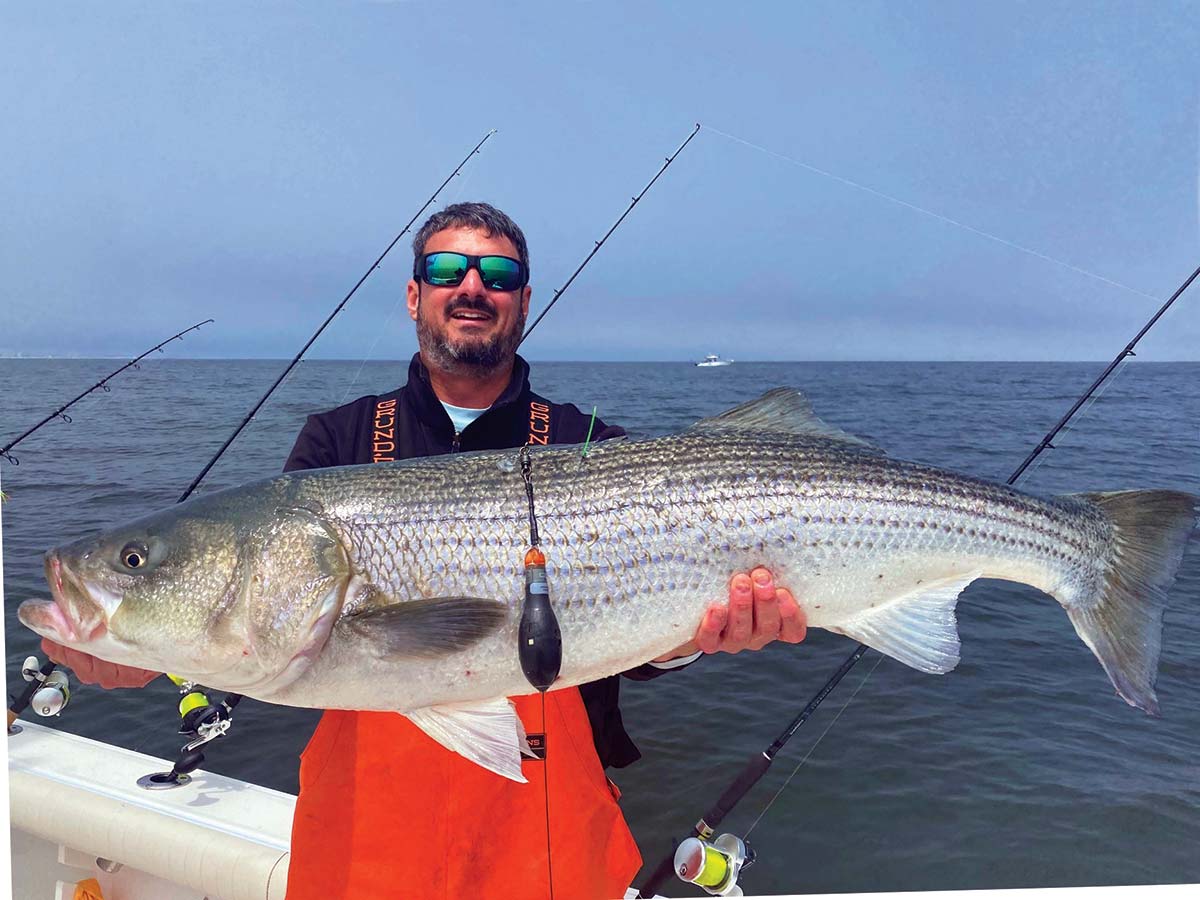
The “Land of Doormats” holds secrets for whales and stripers too.
What do we really know about striped bass patterns and migrations? In looking at the past 3-1/2 years of data gleaned from the Northeast Striped Bass Study, perhaps about as much as we think we know about whales. For example, here’s an interesting quote by researchers that’s contained in the NOAA Technical Memorandum now being used by the Office of Protected Resources at NOAA Fisheries to assess the risk of vessel strike mortality in North Atlantic right whales along the U.S.
“Recent survey data in the Nantucket Shoals region indicate large aggregations of NARWs (North Atlantic right whales) occurring year-round in this area that had not previously been identified as a persistent habitat.”
The major issue in the recreational fishing and boating community related to this whale memo of course is NOAA Fisheries proposed a rule to broaden the current 10-knot speed restriction along the Atlantic Coast to include vessels 35 feet and larger Does the science show a need for reduced speed? Depends on how deep you actually dive into the specifics.
According to the government memo, intensive aerial surveys conducted over Nantucket Shoals show high densities of right whales, which the federal government research itself admits “This localized high density strongly influences the mid-Atlantic regional model and may result in positively biased density estimates.”
From a layman’s perspective, that statement by the federal government claims how a preponderance of whales at Nantucket Shoals can throw off the entire coastwide model for this highly endangered species of marine mammal. Or as the memo itself admits of whale numbers observed at Nantucket Shoals, “the high densities predicted along the mid-Atlantic may not be realistic.”
Ironically, the past few years of satellite tagging data from the Northeast Striped Bass Study shows a preponderance of big striped bass fitted with tags showing up along the Nantucket Shoals during the summer months; you have to wonder how this “localized high density” fits into the long held views on striped bass migration.
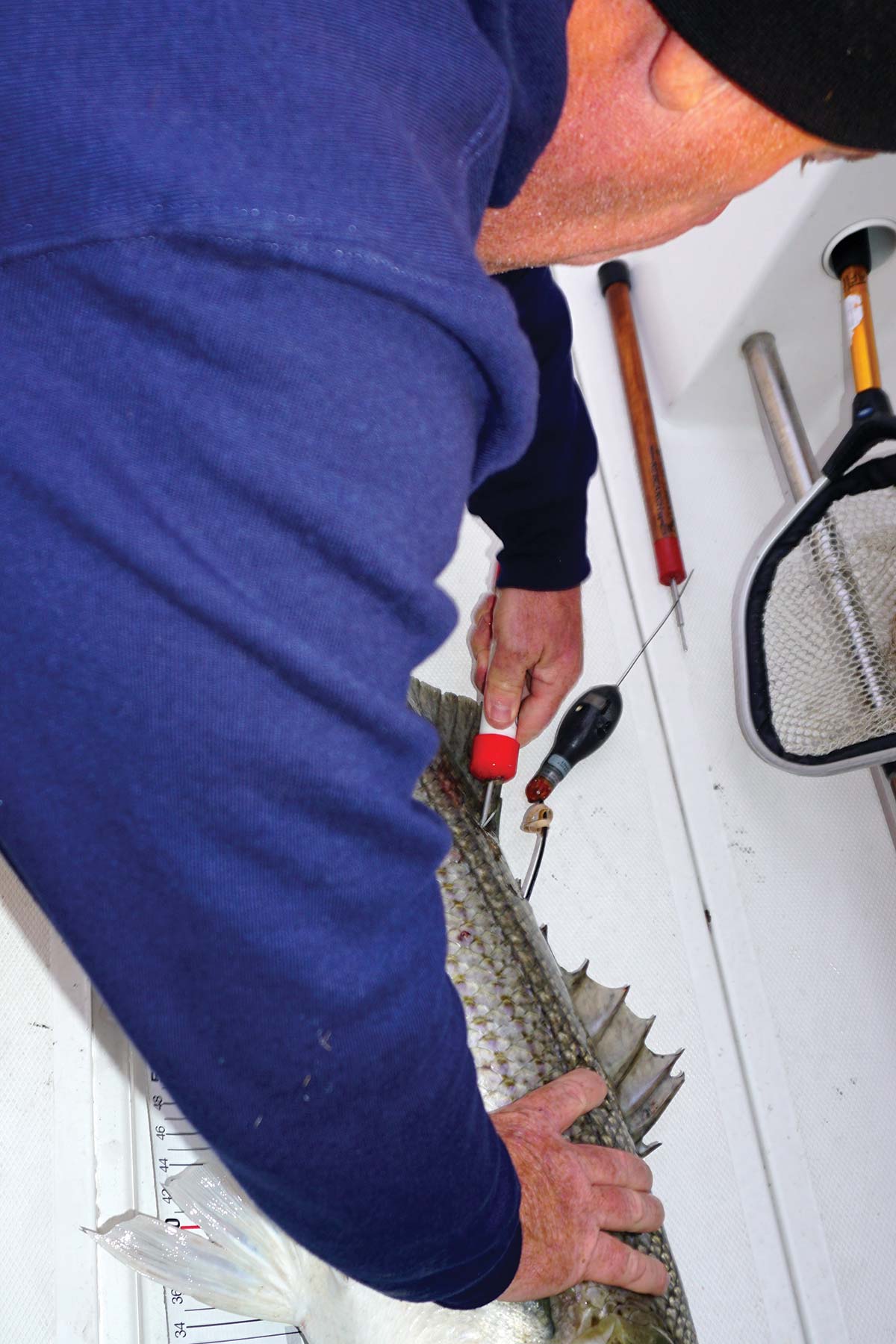
High Density Zone
According to the United States Coast Pilot distributed annually by the Office of Coast Survey, the Nantucket Shoals extend eastward from Nantucket, MA for 23 miles and southeastward for over 40 miles; while water depths along this particular stretch can vary – from 3 to 4 feet in some areas to as much as 4 or 5 fathoms on others – accurate depth soundings are fairly unpredictable due to strong currents and ever-changing bottom.
In recent years, this expansive area off the southeast corner of Nantucket has become known by anglers as “The Land of Doormats” due to the sheer volume of double-digit fluke weigh-ins. “The unbelievable doormat fluke opportunities in and around Nantucket is no longer a secret in the Northeast or Mid-Atlantic region,” wrote Capt. Scott Newhall in a 2018 article in The Fisherman, remarking how many of our subscribers book one or a two charters a year for the Nantucket Shoals specifically to find a whale of a fluke to weigh in for the Dream Boat Fishing Challenge.
But as noted New England author and fisherman Charley Soares noted in his Nantucket Shoals: Fluking Uncharted Sand piece in the July, 2022 New England edition it’s not just whales and doormats either. “Long before Nantucket became the leading destination for slab-sized summer flounder we would watch the weather and make an occasional foray to the rips at Tuckernuck and Muskegut shoals where a man, who was not intimidated by those ever-changing rips, could bounce a bucktail and fill a box or two with brawny stripers,” Soares wrote, detailing how the occasional double-digit bluefish also prowled the same turmoil of waves and sand.
Soares went on to share a story about the late Capt. Roger Jarvis who registered a 60-pound cod and 50-pound striper at Nantucket Shoals on the very same trip several decades ago, noting how fluke were competing for bait with stripers in the 20- to 30-pound class. “That was then and this is now,” he added.
Of course, now means most of the Nantucket Shoals grounds – particularly the most productive areas – are off limits to striped bass due to being located outside of the three-mile line. In the 1990’s any and all directed fishing for striped bass (which includes targeted catch and release) was prohibited in the Exclusive Economic Zone (EEZ) extending from 3 miles to 200 miles offshore. That was followed up by an executive order signed on October 20, 2007 by President George W. Bush which prohibited the sale of striped bass and red drum caught within the EEZ.
While perhaps mostly a symbolic gesture given the existing EEZ prohibition, the president also noted during the official signing of his commitment to directing federal agencies to work with state officials to find innovative ways to help conserve striped bass. “One such way is to use the state designation of ‘gamefish’ where appropriate,” President Bush said, adding “I hope the state officials take a serious look at gamefish designation; it is an effective tool to protect endangered or dwindling species. See, it prohibits commercial sales, which removes the incentive to catch the fish for anything other than recreational purposes.”
So striped bass are protected outside of 3 miles from shore, which is good. Yet 15 years later, the only coastal states with gamefish protection for striped bass are Maine, New Hampshire, Connecticut, Pennsylvania, New Jersey and South Carolina. Which brings us back to the Nantucket Shoals.
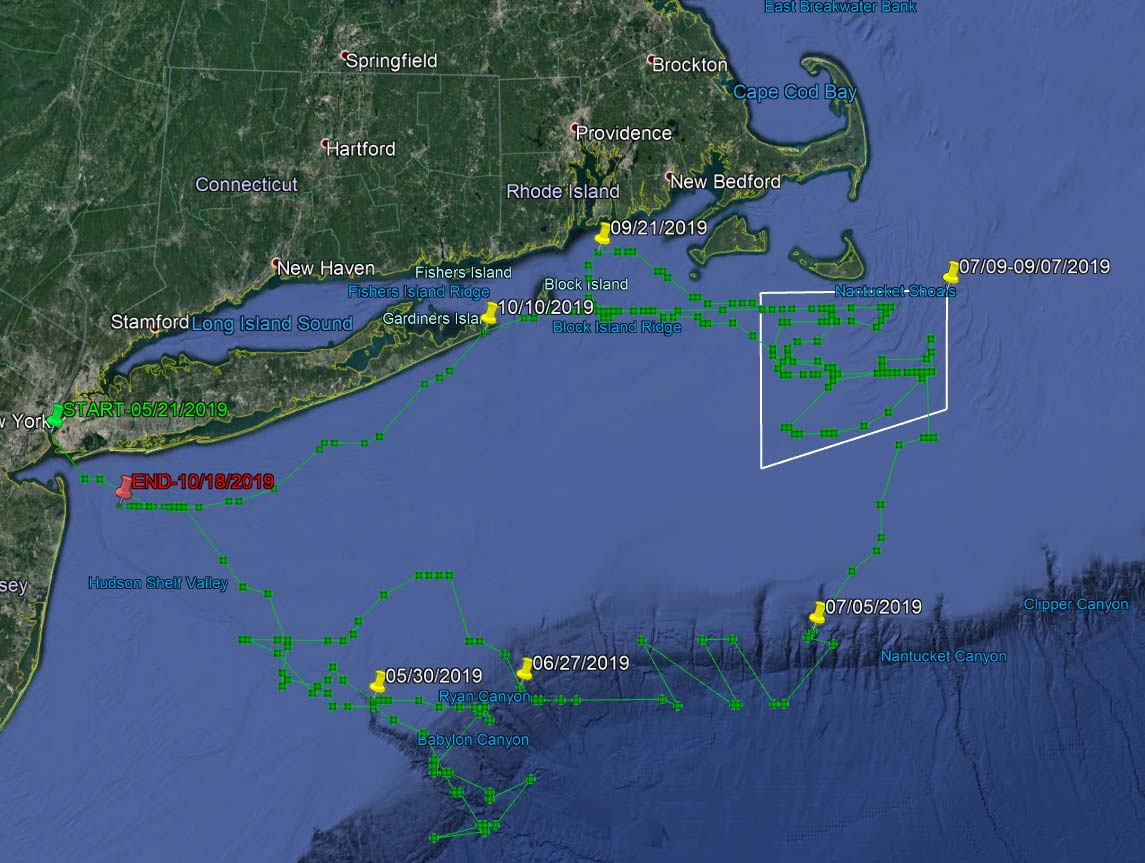
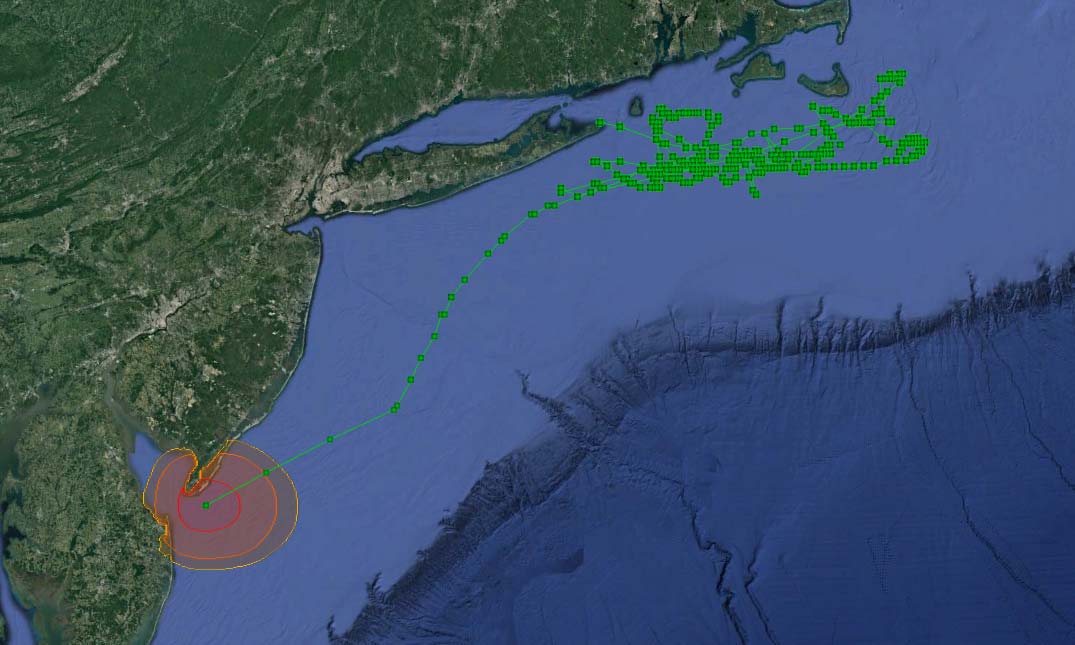
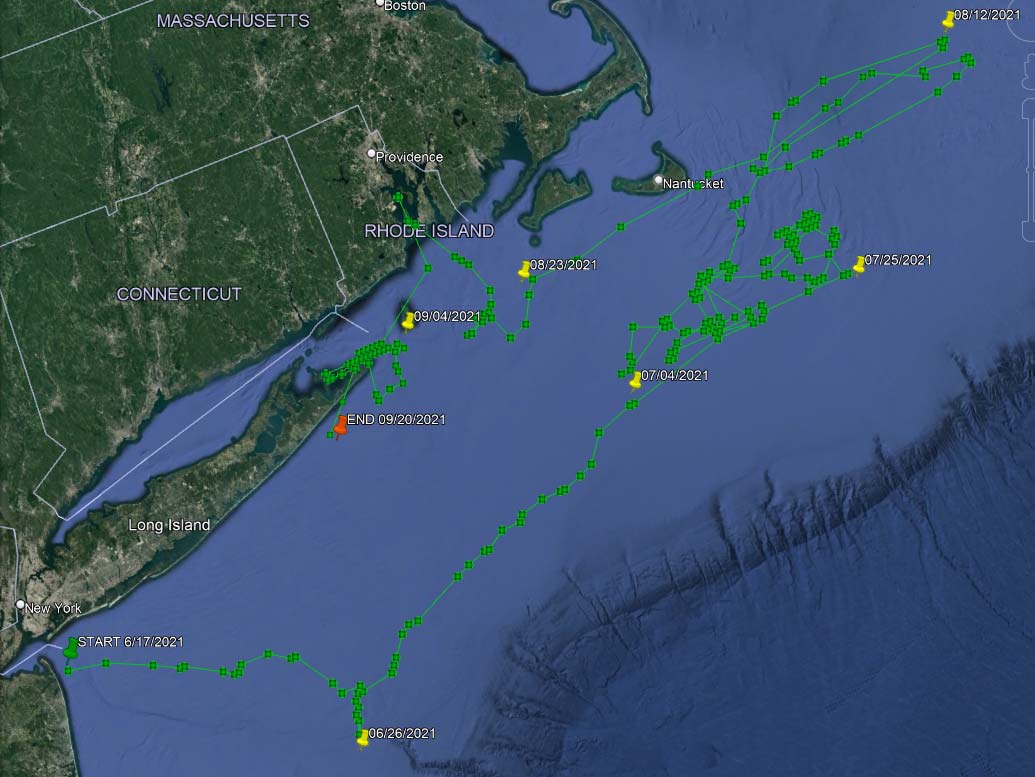
A Nantucket Sleigh Ride
In our October, 2022 edition we provided a three-year timeline (‘22 SAT Tag Update: A Northeast Striped Bass Study Primer) of our collective efforts with Gray Fishtag Research in deploying MiniPAT devices in striped bass along the Atlantic Coast. Out of a dozen tags deployed in spawning class stripers over a 3-year period, eight have been physically recovered.
In the October edition of The Fisherman we displayed the charting details of 10 out of those 12 fish; but of the eight big stripers that we tagged in the spring (two were deployed in the fall during the southern migration), seven of those bass spent at least part of the summer months in the area of Nantucket Shoals. Five fish in particular, Freedom (deployed May 21, 2019 in the Hudson River near the Statue of Liberty), Rona (deployed May 28, 2020 off Sandy Hook, NJ), Independence (deployed July 3, 2020 off Montauk, NY), Hail Mary (deployed June 17, 2021 in Raritan Bay) and PENN (deployed June 30, 2021 off Montauk, NY) showed an especial affinity for the Nantucket Shoals area
The striped bass we named Freedom, Independence and Hail Mary in particular had a heavy accumulation of clusters in their GPS tracking just southeast of Nantucket during the summer months, with Freedom and Independence spending most of July and all of August at Nantucket Shoals, while Hail Mary found her way up just inside George’s Bank by mid-August after swimming around the shoals throughout the month of July.
A few months ago I got a phone call from Capt. Rick Bellavance of Rhode Island, the president of the Rhode Island Party and Charter Boat Association and at-large representative for the Ocean State at the New England Fishery Management Council. Capt. Bellavance was on his way to an Atlantic States Marine Fisheries Commission (ASMFC) at the time, and we spoke at length about the Northeast Striped Bass Study, including the aggregation of SAT-tagged jumbo stripers in the Nantucket Shoals area. “Herring probably,” Capt. Bellavance said over the phone, adding “it’s about the only place the herring fleet can’t get to them.”
Or as Soares noted in that July, 2022 piece on jumbo fluke, “July and August are excellent months as the squid run is tapering off and the fish transition into sand eels, cunners, scup, lobsters, and crabs.” Along those lines, some fishermen and researchers I’ve spoken to about this striped bass attraction to Nantucket Shoals in the summer months is directly related to the presence of sand eels (sand lance).
Coincidentally – or perhaps not really a coincidence at all – other striped bass we’ve tagged previously (Cora and Rona in 2020) also seemed to be in areas offshore (not far from the Texas Tower, north the Coimbra and Ranger wreck sites ) where whales often tip off tuna fishermen about a good feed. One possible takeaway here is that perhaps the fisheries management world needs a better understanding of the complexities of this particular area of Nantucket Shoals as a Prime Fishing Area along the coast.
In the fisheries world of “best available science,” what don’t we know about these areas of essential fish habitat along the Atlantic Coast, and how can we incorporate new scientific components to help make the available science even better?
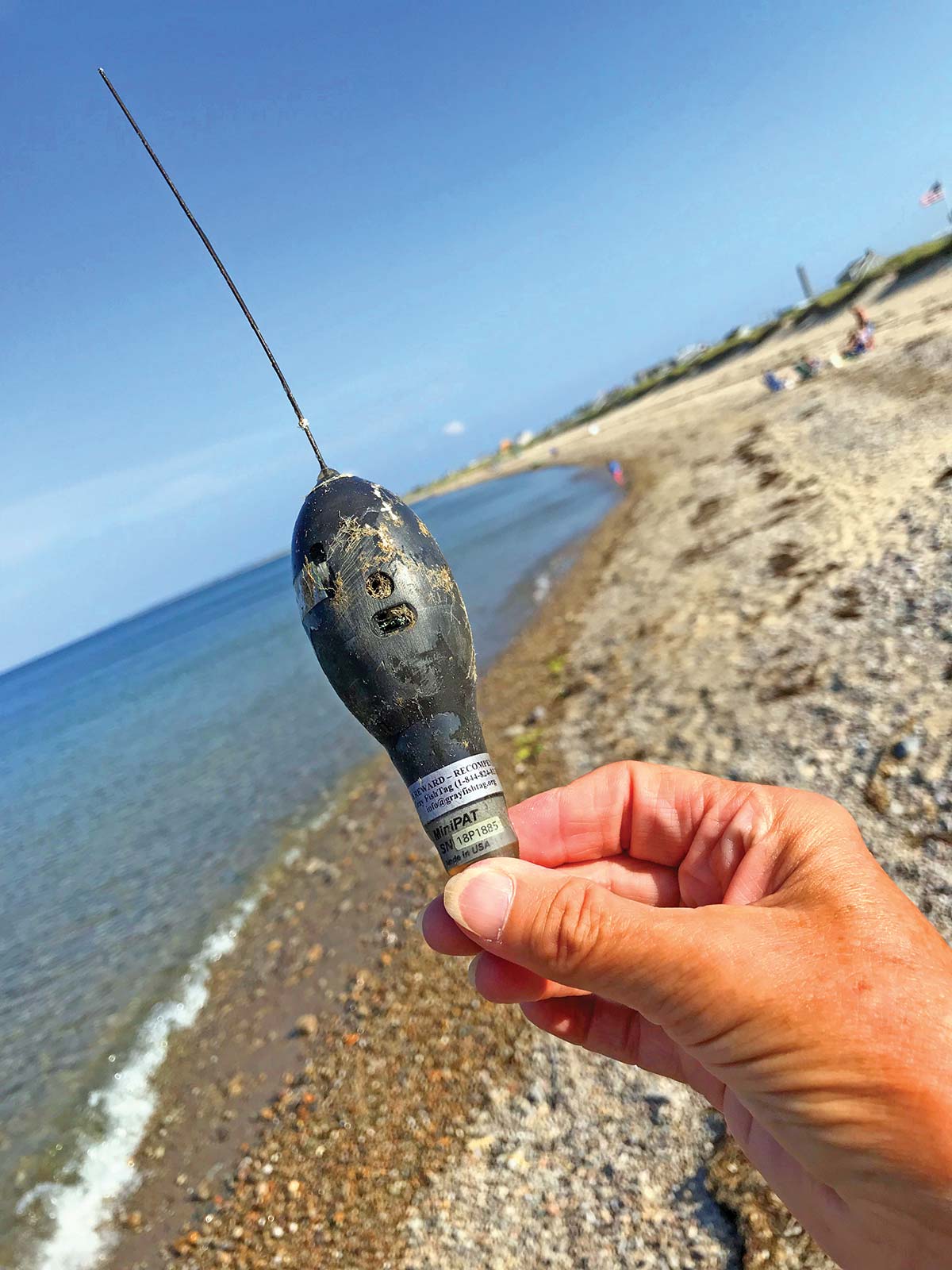
’22 Tagging Efforts
Back in May, we assembled the Northeast Striped Bass Study team – which included many of our 2022 sponsors and financial supporters – out of Bahr’s Landing Marina in Highlands, New Jersey for our annual spring tagging event. The folks from Gray Fishtag Research were there of course with two MiniPAT devices and one mrPAT. At just 40 grams, the mrPAT is the smallest tag in Wildlife Computers pop-up family; just like the larger MiniPAT devices, the mrPAT will automatically deploy when submerged in seawater. After a specified time interval or on an absolute date, the release pin burns through, separating the tag from its tether; it will then float to the ocean surface. Once making contact with the air, a 14-day battery kicks in and the data stored inside the tag itself will begin transmitting to the Argos satellite.
During this year’s event, a 40-inch striped bass named Pappy Jim and a 48-inch striped bass named Van Staal each was caught and released with a MiniPAT attached, while a 48-inch striped bass named Seaguar Striper was fitted with the new mrPAT. Regrettably, the tags implemented in both Pappy Jim and Seguar Striper came undone from the fish well premature of the preset time. And because the two stripers seemed to stay inside the Shrewsbury River (where they were originally caught and tagged) during the short duration of tracking, they were actually too close to land masses and buildings along the coast to make the data too reliable.
The MiniPAT in Van Staal on the other hand remained intact for the full 120 days. At first sign of the tag uploading information to the Argos satellite our team was excitedly awaiting new information. Regrettably, the MiniPAT from Van Staal stopped transmitting and sending data after just one day, well short of the 14-day battery life. The last reported location of that device came from Hull, Massachusetts at the approximate LAT/LON numbers of 42° 18.338’N / 70° 52.975’W. It’s possible that the tag became buried, physically destroyed or perhaps even recovered by an individual who is unaware of what they’ve found.
There’s still a cash reward being offered for the return of this MiniPAT device, and the Northeast Striped Bass Study team remains hopeful that this particular tag might someday be found and returned to Gray Fishtag Research. However, this year’s satellite research work is not done.
In addition to the MiniPAT and mrPAT devices designed for larger, 34-inch and over fish, the Washington-based technology company that builds these high-tech units sent two new devices out this past summer designed for smaller specimens. On August 18, Capt. Guy Buono and I deployed a Wildlife Computers microPAT device in a 29-inch striper (N40° 36.486’ / W74° 02.350’) near the Verrazano Bridge; less than three weeks later we had our first Sat-Tagged striper in New England waters as Chris Scanzillo and Tim Geary tagged a 32-inch striped bass of Massachusetts (N42° 9.569’ / W70° 41.922’) on September 5.
| ’22 STUDY SPONSORS |
| The ongoing Northeast Striped Bass Study partnership with Gray Fishtag Research and The Fisherman Magazine would not be possible without the incredible financial support of our sponsors, including American Fishing Wiring (AFW), Berkeley Striper Club, CAT Marine, Fin-Nor, the Fisheries Conservation Trust, Hudson River Fishermen’s Association, LBI Surf Fishing Classic, the Many, Glassberg and Nova families, Montauk Surfcaster Association, New York Sportfishing Federation, PENN, the Raritan Bay Anglers Club, Reel Max Life / NJ SAT Fest, Seaguar, Simrad and Van Staal.
To learn more about Gray Fishtag Research and how you can make a tax-deductible charitable donation to the Northeast Striped Bass Study contact Roxanne at 844-824-8353 or [email protected]. |
As with the MiniPAT and mrPAT devices, the microPAT has been programmed with a pre-set date, and which point the tag should “pop off” from each striper and upload summary of archived data to Argos. Of course, as we’ve been boldly reminded in 2022, things don’t always turn out as planned.
“This type of research work comes with great risk, expense, and pressure for the tags to perform as we expect,” said Roxanne Willmer from Gray Fishtag Research, adding “It is a great reminder that we need more funding to continue this research work to deploy more tags.”
And sometime late in October, or early November, I’ll be out once more with Chuck Many aboard his Tyman out of the Raritan Bay in New Jersey looking to deploy one final MiniPAT of the year into what we believe will be a southbound striped bass. Last year we tagged a fish named Uncle Fred in early November which popped up inside the Chesapeake Bay three months later, the MiniPAT itself found not far from Tangier Island in early February.
Onward!




